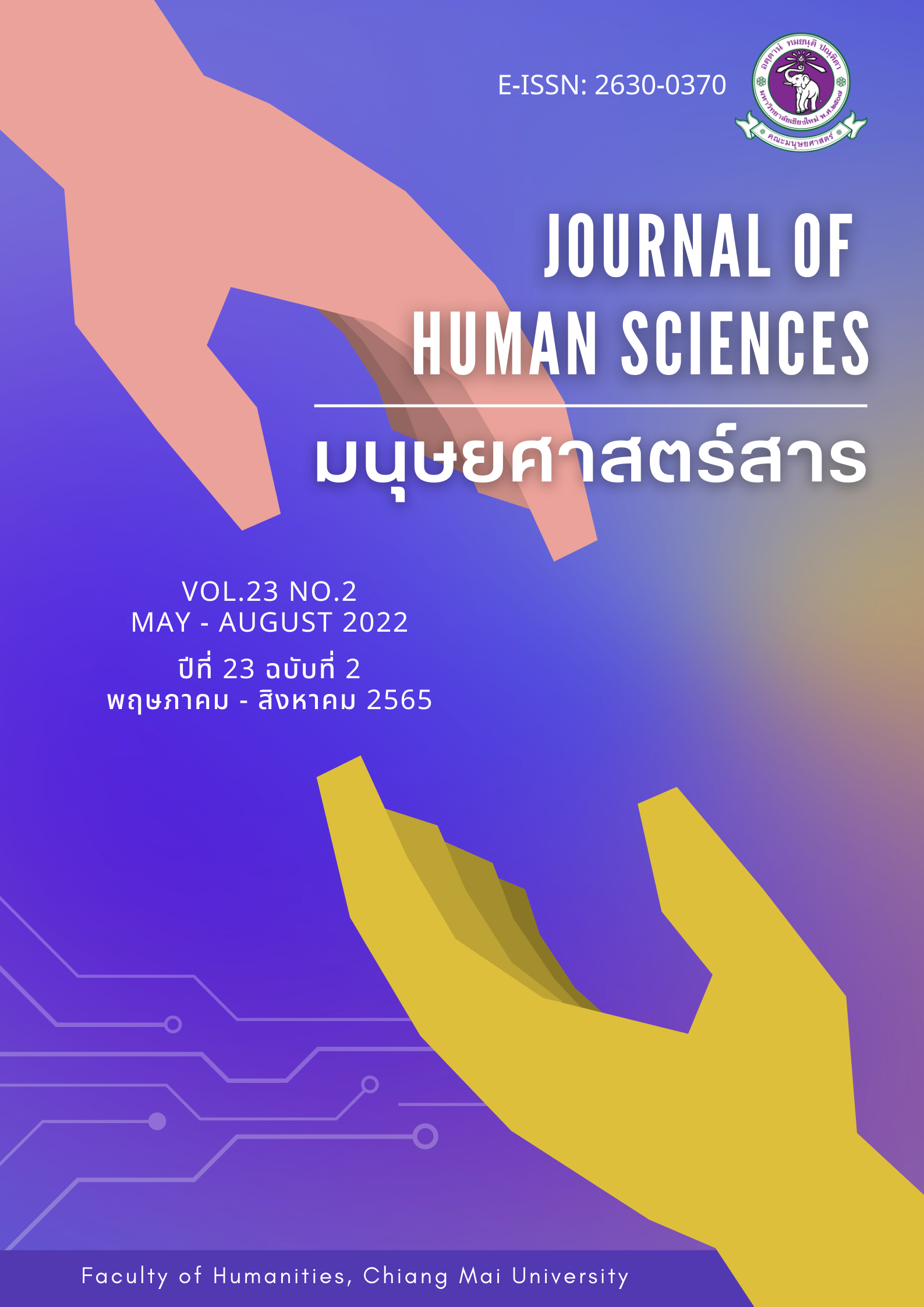การวิเคราะห์โอกาสและแนวทางการพัฒนาศักยภาพการท่องเที่ยวเชิงสุขภาพ ประเภทน้ำพุร้อนธรรมชาติ โดยชุมชนในจังหวัดเชียงใหม่ เพื่อรองรับการท่องเที่ยววิถีใหม่ (New Normal Tourism)
Main Article Content
บทคัดย่อ
การวิจัยในครั้งนี้มีวัตถุประสงค์เพื่อวิเคราะห์โอกาส และเสนอแนวทางการพัฒนาศักยภาพการท่องเที่ยวเชิงสุขภาพประเภทน้ำพุร้อนธรรมชาติโดยชุมชนในจังหวัดเชียงใหม่ เพื่อรองรับการท่องเที่ยววิถีใหม่ (New Normal Tourism) โดยทำการเก็บรวบรวมข้อมูลจากการสัมภาษณ์กับกลุ่มประชากรตัวอย่างจำนวน 484 ตัวอย่าง ได้แก่ กลุ่มหน่วยงานภาครัฐ ภาคเอกชน หน่วยงานท้องถิ่น ชุมชนท่องเที่ยว และ นักท่องเที่ยวภายในประเทศ นำข้อมูลจากการสัมภาษณ์มาวิเคราะห์สถิติเชิงพรรณนา ความถี่ และร้อยละ โดยทำการวิเคราะห์ SWOT พร้อมทั้งสร้างกลยุทธ์ TOWS matrix พบว่า จุดแข็งที่สำคัญที่สุด คือ ความอุดมสมบูรณ์ของทรัพยากรธรรมชาติ มีผู้รับการสัมภาษณ์ตอบในประเด็นนี้จำนวน 98 คน (ร้อยละ 20.25) จุดอ่อนที่สำคัญที่สุด คือ มาตรฐานด้านการท่องเที่ยว บุคลากรการท่องเที่ยว และมาตรฐานด้าน SHA มีผู้รับการสัมภาษณ์ตอบในประเด็นนี้จำนวน 101 คน (ร้อยละ 20.87) โอกาสที่สำคัญที่สุด คือ การพัฒนาการท่องเที่ยวเชิงสุขภาพ ด้วยการบำบัดด้วยน้ำ มีผู้รับการสัมภาษณ์ตอบในประเด็นนี้จำนวน 102 คน (ร้อยละ 21.07) และการสร้างรายได้สู่ชุมชน มีผู้รับการสัมภาษณ์ตอบในประเด็นนี้จำนวน 99 คน (ร้อยละ 20.45) และอุปสรรคที่สำคัญที่สุด คือ ปัญหาการระบาดของเชื้อไวรัสโควิด 19 มีผู้รับการสัมภาษณ์ตอบในประเด็นนี้จำนวน 108 คน (ร้อยละ 22.31) จากการวิเคราะห์ศักยภาพของชุมชนสามารถสร้างกลยุทธ์การดำเนินงาน ประกอบไปด้วย 1) ภาครัฐ ได้แก่ (1) การจัดทำนโยบายและเชื่อมโยงแหล่งท่องเที่ยวน้ำพุร้อนธรรมชาติ (2) การจัดสรรงบประมาณ (3) การปรับปรุงสาธารณูปโภคพื้นฐาน (4) การจัดทำนโยบายเชื่อมโยงแหล่งท่องเที่ยวน้ำพุร้อนธรรมชาติกับการท่องเที่ยวเชิงสุขภาพอื่น ๆ (5) การควบคุมปริมาณนักท่องเที่ยว และ (6) การปรับปรุงแผนการประชาสัมพันธ์ 2) ภาคเอกชน ได้แก่ (1) การสร้างความเชื่อมโยงกับการท่องเที่ยวแบบวารีบำบัด (2) การสร้างและออกแบบกิจกรรมการท่องเที่ยวแนวใหม่ และ (3) การสร้างความร่วมมือกับชุมชนท้องถิ่น และ 3) ภาคชุมชน ได้แก่ (1) การสร้างเอกลักษณ์และอัตลักษณ์เกี่ยวกับวารีบำบัด และ (2) การสร้างความเข้มแข็งของเครือข่ายชุมชน ซึ่งเป็นจุดเริ่มต้นของการดำเนินงานด้านการท่องเที่ยวน้ำพุร้อนธรรมชาติในอนาคต
Article Details

This work is licensed under a Creative Commons Attribution-NonCommercial-NoDerivatives 4.0 International License.
References
Chuamuangphan, N. (2014). kanphatthana sakkayaphap kho̜ng læng namphu ro̜n nai phumiphak tawantok kho̜ng prathet Thai phưa kantho̜ngthieo thi yangyưn [The development of hot springs’ potential in the West of Thailand for sustainable tourism Thailand] National Research Council of Thailand (NRCT) & Thailand Research Fund.
Chaisaengpratheep, N. (2013). næothang kanphatthana kanmi suanruam khong chumchon talat boran bang phli phưa kanthongthieo yang yangyưn [Guidelineof Community Participation Development in the Old Bangplee Market for Sustainable Tourism]. Veridain E-journal, 6(3). 638.
Department of Mineral Resources. (2016). namphu ron nai prathet Thai [Hot springs in Thailand]. Retrieved from http://www.dmr.go.th/main.php?filename=hotthai.
Department of National Parks, Wildlife and Plant Conservation. (2020). chamnuan naktho̜ngthieo læ yanphahana thi khaopai wanautthayan [Number of tourists and vehicles entering the forest park] Retrieved from http://portal.dnp.go.th/Content/nationalpark? contentId=22377.
Department of Tourism, Ministry of Tourism and Sports. (2014). kanchat borikan nai sathanprako̜pkan thongthieo chœng sukkhaphap [Wellness services standard for Tourism] (13-24). Bangkok: Chulalongkorn University.
Konisranukul, W., Tuaycharoen, N., & Aumkratum, S. (2011). kanphatthana læng thongthieo
namphu ron thammachat phưa kantho̜ngthieo chœng sukkhaphap duai kanmi suanruam khong chumchon ko̜rani sưksa phu ro̜n phraruang changwat Kamphæng Phet [Community Participatory Development of Natural Hot Springs for Health Tourism: A
Case Study of Praruang Hot Spring, Kamphangphet Province]. The Graduate Research Conference (Khon Kaen University 2011).
Lamaigeen, K. (2009). ongprako̜p kanthongthieo [Tourism Element] (5-6) Ubonratchathani: Ubonratchathani University.
Manirochana, N. (2021). kanphatthana sakkayaphap kho̜ng læng namphu ro̜n ban no̜ngcharœn changwat Kanchanaburi sarapro̜ngrap kantho̜ngthieo munlakha sung
[Potential Development of Hot Spring Destination at Ban Nong Charoen Kanchanaburi Province for High Value Tourism]. Philosophical Vision Journal, 26(1). 164-169.
Ministry of Tourism and Sports. (2020). khrongkan phưa kan songsœm kanthongthieo yang yangyưn [Sustainable development Project]. Sustainable development Project. 27-28.
Panich, N., Srapkhet, K., & Poopuk, K. (2019). kanphatthana kan bo̜rikan su mattrathan khwamplo̜tphai dan suk anamai (SHA) phan phe cho̜ fetbuk borisat sawatdi sawen krapo̜ æ sansapo̜t kat [Service Develop to the Safety & Health Administration (SHA) Standard Through facebook page of Sawasdee Travel Group & Transport Co. Ltd]. (Master of Liberal Arts thesis, Siam University).
Prachachat. (2020). Chiang Mai dan medikhon - wennet [Chiang Mai pushes Medical- Wellness]. Retrieved from https://www.prachachat.net/local-economy/news-494498.
Sinthawanon, W., & Eiamnakha, N. (2018). kan wikhro huang so khunkha khwamru phưa phatthanakan thongthieo chœng sukkhaphap withi Thai nai senthang sai phu ron kho̜ng prathet Thai korani sưksa : bo phu ron khem khlong thom changwat Krabi læ bo phu ron chæ so on changwat Lampang [Knowledge Value Chain Analysis
The Implementation of Hot spring Health Tourism Development in Thailand:
A Case study of Klongtom Hot Spring, Krabi and Jaeson Hot Spring Lampang]. National Research Council of Thailand (NRCT).
Sirisuthikul, W. & et al. (2014). kanphatthana kan bo̜rikan su mattrathan khwamplo̜tphai dan suk anamai (SHA) kan khwamphưngphochai læ khwam phakdi to tra khong nakthongthieo tang chat thi mi to thurakit sukkhaphap ong ruam khong Thai phưa kanphatthana kon yut su kan pen sunklang kanthongthieo chœng sukkhaphap nai klum prachakhom setthakit Asian [A Survey of Satisfaction and Brand Loyalty of Foreign Tourists toward Thai Holistic Wellness Centers for Strategic Development of Thailand as Health Tourism Hub in ASEAN Countries]. Thailand Research Fund.
Sirivejjabhandu, A. (2021). kanphatthana kantho̜ngthieo chumchon su mattrathan khwam pakati mai ( New Normal ) phưa ro̜ng rap sathanakan rok titchưa wairat khorona so̜ngphansipkao ko̜rani sưksa chumchon no̜ng ha amphœ huai thap than changwat Si Sa Ket [Community-Based Tourism in New Normal Way during the
COVID-19 Crisis: A Case of Nong Ha Community, Huai Thap Than District,
Sisaket Province]. Humanities and Social Sciences Journal, Ubon Ratchathani Rajabhat University, 12(1). 69.
Sitikarn, B., Pathan, A., Gateubol N., & Prangkham, P. (2016). kan songsœm kanchai phumpanya tho̜ngthin nai kanchatkan kantho̜ngthieo doi chumchon nai phưnthi chat phan nai kon changwat arayatham lanna [Promotion of Local Wisdom in Community- based Tourism Management in Ethnic Communities in the Lanna Civilization Cluster]. Management Science Journal, Chiangrai Rajabhat University, 13(2). 185.
Srithong, A. (2015). namphu ro̜n ( Onsen ) : nawattakam kanchatkan tho̜ngthieo phưa sukkhaphap læ bat doi kanmi suanruam kho̜ng chumchon [Hot Spring (Onsen) : An Innovation of Tourism Management for Health and Therapy by Community’s Participation]. Research Network Mahachulalongkornrajavidylala University Office of the Higher Education Commission : OHEC.
Suansri, P. (2003). khumư kanchatkan thongthieo doi chumchon [Community based tourism handbook] (15). Chiang Mai: Wanida karnpim limites partnership.
Thaotrakool N. & Wannaluk P. (2020). kantatsinchai thongthieo khong nakthongthieo chao Thai nai læng thongthieo chœng sukkhaphap nai changwat Chiang Mai [Guidelines for Marketing Communication Development of Health Tourism at Samoeng District and
Mae-On District in Chiang Mai Province]. Christian University Journal, 26(2). 72-83
Tourism Authority of Thailand. (2022). Amazing Thailand Safety and Health Administration (SHA). Retrieved from https://web.thailandsha.com/index.
Tawisri, V. (2014). attalak chumchon : næokhit læ kanchatkan phưa kanthongthieo yang yangyưn doi lak phut santiwithi khong thetsaban tambon chiang khan changwat lœi [Identity of Community: Concept and Management for Sustainable
Tourism by Buddhist Peaceful Means of Chiangkhan Municipality, Lei Province].
Journal of Arts Management, 1(2). 68-71.
Weerakit, N., Chaiyasain, C., Aksornpairoj, P., & Sonpiam, S. (2019). næothang kanphatthana kanthongthieo chœng kanphæt khong changwat Phuket phưa yok radap su kan pen sunklang nana chat kanthongthieo chœng sukkhaphap [The Development Guidelines of Medical Tourism to Upgrade Phuket to be an International
Medical Hub]. Journal of International Thai Tourism, 15(2). 49-54.

